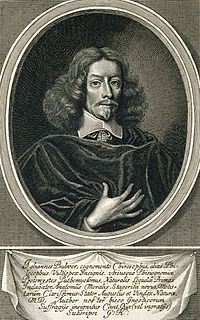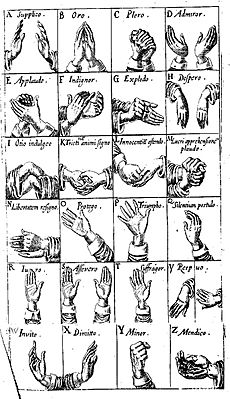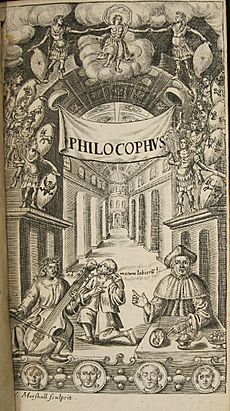John Bulwer facts for kids
Quick facts for kids
John Bulwer
|
|
|---|---|

Engraving of John Bulwer by William Faithorne. Made around 1653 for the book Anthropometamorphosis
|
|
| Born |
John Bulwer
16 May 1606 baptised |
| Died | circa 1 October 1656 (aged 50) |
| Resting place | St Giles in the Fields, Westminster. |
| Nationality | English |
| Education | Probably went to Oxford. |
| Alma mater | Got an MD from an unknown European university |
| Occupation | Physician |
| Known for | writer of five works exploring the Body and human communication, particularly by gesture. |
| Title | Chirosopher |
| Spouse(s) | Woman only known as the "Widow of Middleton" |
| Children | Adopted daughter, named Chirothea Johnson |
| Parent(s) | Thomas Bulwer and Marie Evans |
| Signature | |
 |
|
John Bulwer (born 1606 – died 1656) was an English physician. He was also a natural philosopher, which means he studied nature and the world around him.
Bulwer wrote five important books. These books explored the human body and how people communicate. He was especially interested in how we use gestures. He was also the first person in England to suggest that deaf people could be educated. He wrote about his ideas for a special school in his books Philocophus and The Dumbe mans academie.
Contents
John Bulwer's Life Story
John Bulwer was born in London in 1606. He lived and worked in London until he passed away in October 1656. He was buried in St Giles in the Fields, Westminster.
He was the only son of Thomas Bulwer, who was an apothecary. An apothecary was like a pharmacist who prepared and sold medicines. John's mother was Marie Evans.
When his mother died in 1638, John inherited some land. This land gave him a small income. We don't know much about his early schooling. However, he likely studied at Oxford University in the 1620s. Many of his friends went there.
Later in his life, between 1650 and 1653, he earned a medical degree (M.D.). He got this degree from a university in Europe, but we don't know which one.
In 1634, he married a woman known only as the "Widow of Middleton." She died before him. They did not have any children together. Later, Bulwer adopted a girl named Chirothea Johnson. He said in his will that he "bred her up from a child as my own." She might have been deaf.
John Bulwer's Books
During the English Civil War, John Bulwer stopped working as a physician. He spent his time studying and writing instead. All his books were written between 1640 and about 1653.
Bulwer published five books in total. Each of his works was either an early example or the very first of its kind.
Chirologia and Chironomia
His books Chirologia and Chironomia were published together in 1644. Chirologia is about the "natural language of the hand." It explores how we use hand movements and gestures to communicate. Chironomia is about the "art of manual rhetoric." This means it teaches how to use hand gestures effectively when speaking in public.
Bulwer believed that hand gestures were a universal language. He thought everyone could understand them, no matter what language they spoke. He wrote that the hand "speaks all languages." He called it "the Tongue and General language of Human Nature."
Chirologia is often linked to the study of deaf communication. This is because it focuses on hand gestures. Bulwer mentioned that deaf people could communicate well through signs. He saw this as a special gift from nature. He wrote that deaf people "can argue and dispute rhetorically by signes."
Some handshapes described in Chirologia are still used in British Sign Language today. Bulwer also talked about fingerspelling. He described how people in ancient times used to "order an alphabet upon the joints of their fingers." He thought these manual alphabets could be used for secret messages.
Chirologia is a collection of hand gestures. It explains their meanings using examples from literature, religion, and medicine. Chironomia is a guide for using gestures well when giving a speech.
Philocophus: Helping Deaf People
Philocophus: or, the deafe and dumbe mans friend was published in 1648. In this book, Bulwer was the first person in Britain to talk about educating deaf people.
The idea was very new and seemed impossible to many. Bulwer tried to convince "some rational men" to help him start a "new Academy" (a school). But they thought his idea was "paradoxical," meaning it seemed impossible or absurd.
To persuade them, Bulwer explained his theories in this book. He also shared real-life examples. For instance, he wrote about Sir Kenelm Digby's story of a deaf Spanish nobleman. Bulwer also gathered information about deaf people living in Britain at the time.
He observed that some deaf people could "hear" music. They felt the vibrations through their teeth, which is called bone conduction. This led Bulwer to believe that our senses could work together. For example, he thought the eye could "hear" speech by lip-reading.
Pathomyotomia: Muscles and Feelings
Pathomyotomia was published in 1649. This was the first important English book about how muscles show emotions.
Bulwer wanted to create a new, easier way to name the muscles of the face. He suggested naming muscles after the feelings they expressed. For example, a muscle used for happiness would have a name related to joy.
It took 200 years for similar ideas to appear. A French scientist named Duchenne de Boulogne later explored these ideas in his own work. Bulwer also suggested that a real smile of happiness uses a specific muscle around the eye. This muscle does not move in fake or polite smiles.
Anthropometamorphosis: How People Change Their Bodies
Anthropometamorphosis was Bulwer's last and most popular book. It was published in 1650 and reprinted several times. The title means "humanity-changing."
This book explores how people around the world change their bodies and clothes. Bulwer described how "Almost every Nation having a particular whimzey as touching corporall fashions of their own invention." He looked at different cultures and their unique ways of dressing or changing their appearance.
The book also had a deeper meaning. Bulwer believed that nature was perfect and beautiful. He thought that changing our bodies too much was "artificial." He saw nature as a "Monarch," meaning it was like a king ruling over everything. He believed that "The beauty of the Universe consists in things perfect and permanent."
The book has 23 sections. Most of them (15 sections) talk about changes or decorations to the head or face. At the end of the book, Bulwer said he would stop writing. He planned to go back to working as a physician. He wrote that he would now focus on "providing for my own health and the health of others."
Other Writings
Bulwer also wrote some books that were never published. Two of these handwritten books are kept at the British Library.
One is called Philocophus, or the Dumbe mans academie. This manuscript shows that Bulwer was the first person in England to get and translate a book by Juan Pablo Bonet. Bonet's book was about teaching deaf people to speak. Bulwer's manuscript includes pictures and comments from Bonet's book. This manuscript is often called the Dumbe mans academie to tell it apart from his earlier published book, Philocophus.
The other manuscript is called Vultispex criticus, seu physiognomia medici. This book is about Physiognomy, which is the study of how a person's face shows their character.
Some of Bulwer's other works are now lost. These include a study called Glossiatrus about speech disorders. Another lost work was Otiatrus, which was about hearing disorders. Glossiatrus was the first book ever written specifically about speech disorders.



